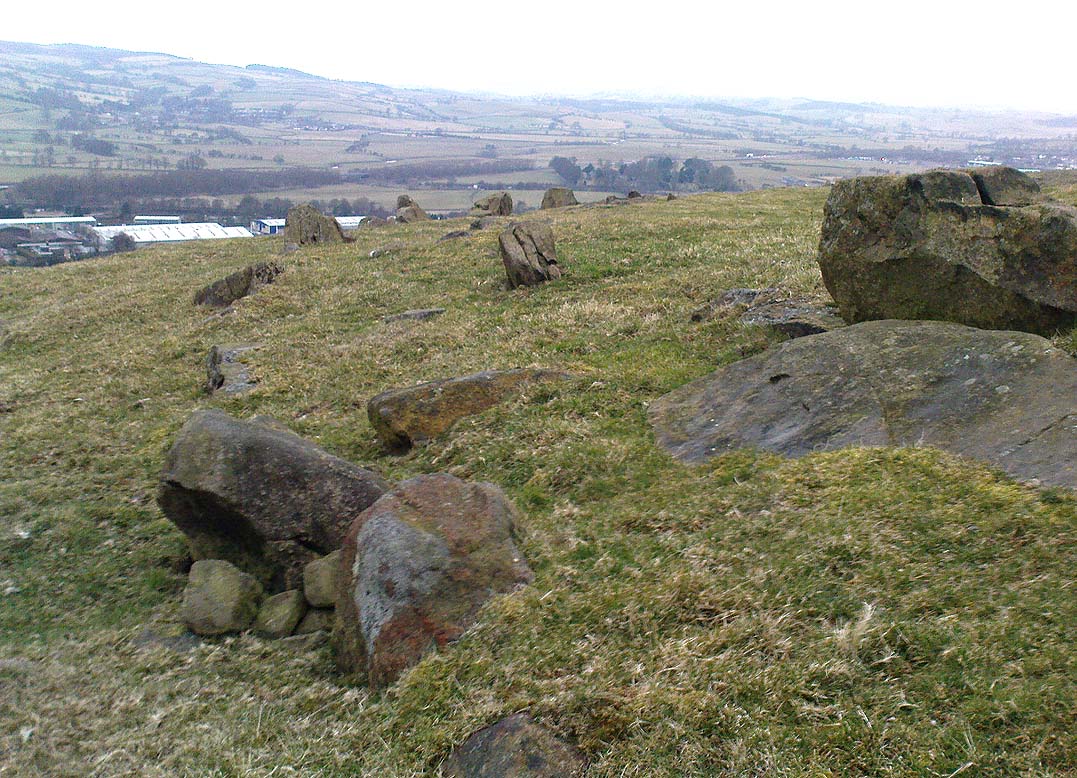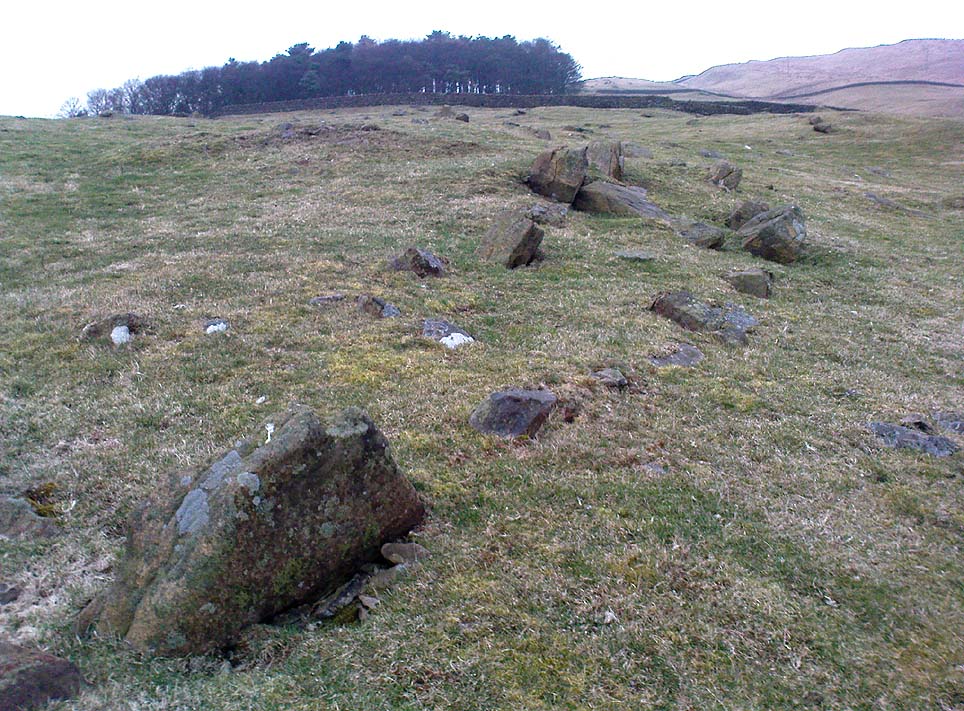Enclosure / Settlement: OS Grid Reference – SD 9966 5046
Also Known as:
- Cawder Hall Enclosure
- MNY21002
- Scheduled Monument 29151
From Skipton town centre follow the A6131 road south, out of town, for less than a mile, and turn left up Cawder Lane. Avoid following the road into the housing, instead bearing up the country lane to your left. Just before reaching the farmhouses 200 yards up, note the stony hilltop above you on your left (up behind Horse Close Farm). Walk up there for 250 yards NE and you’ll find it!
Archaeology & History

This is an impressive site. I’d say very impressive! (but I’m easily pleased) Oddly however, I can’t find a damn thing about this place in any of my archaeo-records and it appears (as far as I’m aware) that no survey has ever been made of it. Which is bloody incredible! Indeed, the only archaeological notes that appear to exist about this very impressive and well-preserved Iron Age enclosure, states, “Subcircular enclosed settlement on Horse Close Hill 250m north of Horse Close Farm.” That’s it! Nothing else! So I’m afraid you’ve only got my crappy description of it to go on for the time being…
As the aerial image below shows, this is a large oval-shaped enclosure, defined primarily by an almost complete ring of double walling arranged around this hilltop site. Measuring approximately 78 yards (71m) north-south, and nearly 75 yards (70m) along its longer east-west axis, with a circumference of about 235 yards (215m), many of the upright stones which define its edges stand between 1-3 feet in height. Some of these stones have obviously been moved into position by the lads who built the structure, but the site has also taken advantage of a number of large earthfast boulders in its construction.
If you walk around the edges of the walled enclosure, almost every bit of it is clearly visible. Between the defining inner and outer walling of the structure we find sections of the site packed with smaller stones, giving the impression that it may once have been filled all round, making the walls thick strong defensive ones. But without a more detailed investigation, we’ll never really know…


It is clearly very similar in structure, and probably date, to the well-known Brackenhall circle on Shipley Glen, near Baildon (though the nature of the Brackenhall site has long been a topic of controversy). And, as with the Brackenhall site, a number of cup-and-ring stones are found close by — including the Great Wood Laithe carving in the field immediately below on the west side. I’ve also found a similar structure to this on the hills above Steeton, a few miles to the south (though it’s not as well-defined as this one).
Although the site is mainly defined by its oval walling, we also find other stretches of walling that run outwards from the central site: one in particular running northeast for 35 yards out towards a small standing-stone further up the field. Other curious earthworks and remains scatter the fields on the eastern sides of this main feature, which the helpful farmer here pointed out to us.
© Paul Bennett, The Northern Antiquarian
The map could not be loaded. Please contact the site owner.
‘JOURNEYS THROUGH BRIGANTIA’ Volume One, John Dixon, AUSSTEIGER PUBLICATIONS
An excavation conducted by Alan Aberg on a circular stone walled enclosure at Horse Hey Farm, Skipton, revealed two hut sites. The larger hut was seen to be oval shape, later convrted into a round house, of 26 ft. dia.
The structure was of timber and in places a 9 inch groove was cut into the bedrock of millstone grit, holding the posts for the walls. There were four 9 inch posts in the centre of the hut circle, being those that held up the roof structure.
The pottery and glass bead found on the site were assigned a pre-Roman Iron Age date, though a Romano-British dress fastening (fibula) was found in the top soil. The other hut was seen to have a sub-rectangular form.
During the work, the major portion of a saddle quern was found in a field wall above Horse Close Hill. And nearby, in the middle of a field alongside Great Wood Laithe (SD 99625055) was noted an outcrop of rock which had almost been levelled with the adjacent field surface by the dumping of boulders from the surrounding ploughland.
On top of the outcrop, that rises to a dome-shaped projection, were found simple cup markings. These average 2 inches in diameter and total 17 in number. The whole surface of the stone is much weathered and good lighting conditions may reveal more details.
Hope that this is helpful
John
See:
E T Cowling in BRADFORD ARCHAEOLOGICAL GROUP BULLETIN IX, (1964), 43.
Horse Hill Close saddle quern & seasons excavation report
The entry on English Heritage’s website has more details now as well as a few references from the Yorkshire Archaeological Society.
“The monument includes an enclosed Iron Age hilltop settlement visible as a sub-circular enclosure c.50m in diameter. It is situated near Skipton, on the top of Horse Close Hill, 250m north of Horse Close Farm. The outer wall consists of a double row of orthostats up to 1m high, with rubble and boulders between. The orthostatic wall appears to be a later addition; originally, the settlement was unenclosed. The enclosed area is sub-divided by a number of additional rubble banks. On the north west side, the enclosure is overridden by a fieldwall, and has been destroyed by quarrying c.1m to the north west of the wall. Hut circles would have occupied the interior of the enclosure and evidence of these will survive beneath the present ground surface. The modern fieldwall on the north west side of the enclosure is excluded from the scheduling, but the ground beneath the wall is included.”